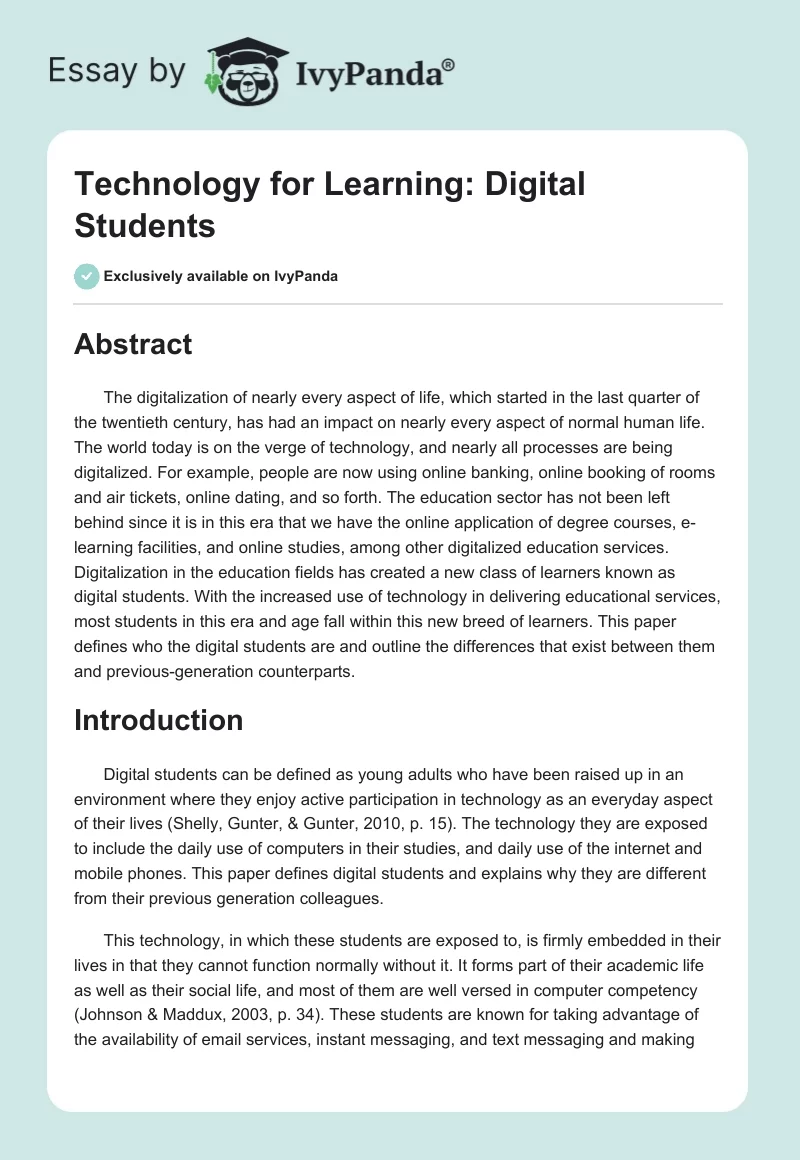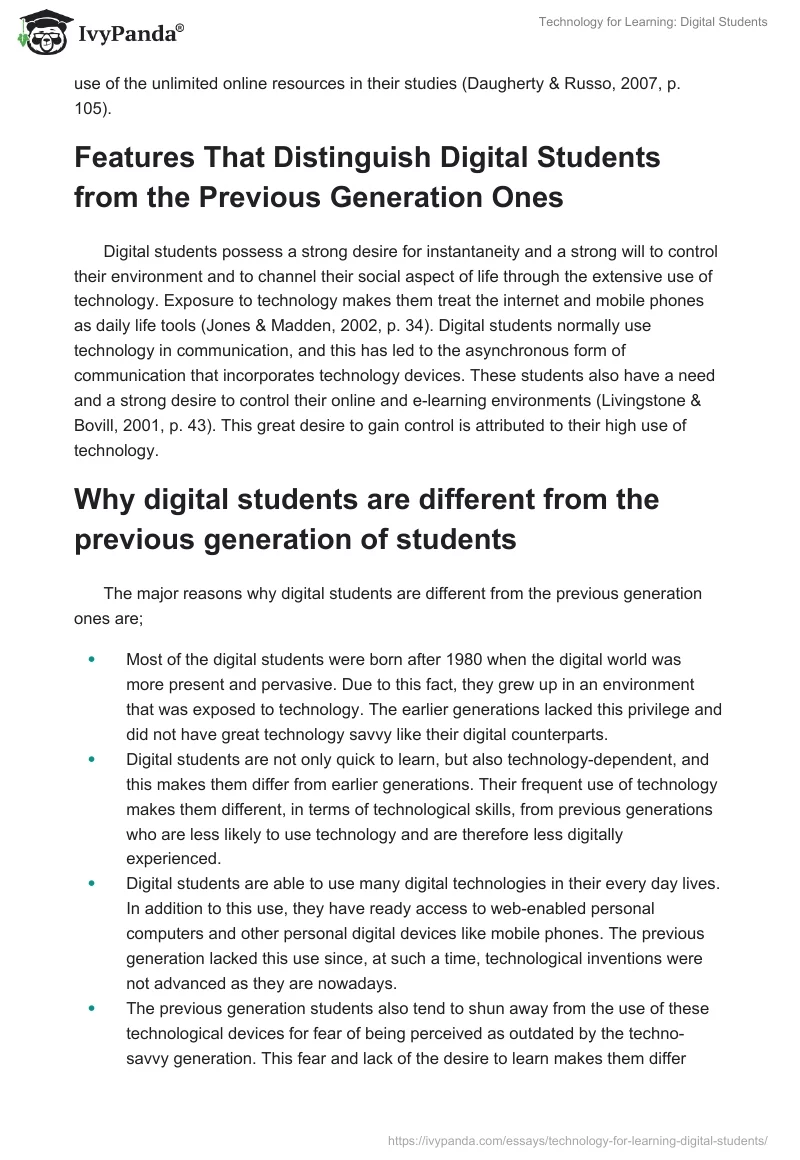Abstract
The digitalization of nearly every aspect of life, which started in the last quarter of the twentieth century, has had an impact on nearly every aspect of normal human life. The world today is on the verge of technology, and nearly all processes are being digitalized. For example, people are now using online banking, online booking of rooms and air tickets, online dating, and so forth.
The education sector has not been left behind since it is in this era that we have the online application of degree courses, e-learning facilities, and online studies, among other digitalized education services. Digitalization in the education fields has created a new class of learners known as digital students. With the increased use of technology in delivering educational services, most students in this era and age fall within this new breed of learners. This paper defines who the digital students are and outline the differences that exist between them and previous-generation counterparts.
Introduction
Digital students can be defined as young adults who have been raised up in an environment where they enjoy active participation in technology as an everyday aspect of their lives (Shelly, Gunter, & Gunter, 2010, p. 15). The technology they are exposed to includes the daily use of computers in their studies and daily use of the internet and mobile phones. This paper defines digital students and explains why they are different from their previous generation colleagues.
This technology, in which these students are exposed to, is firmly embedded in their lives in that they cannot function normally without it. It forms part of their academic life as well as their social life, and most of them are well-versed in computer competency (Johnson & Maddux, 2003, p. 34). These students are known for taking advantage of the availability of email services, instant messaging, and text messaging and making use of the unlimited online resources in their studies (Daugherty & Russo, 2007, p. 105).
Features That Distinguish Digital Students from the Previous Generation Ones
Digital students possess a strong desire for instantaneity and a strong will to control their environment and to channel their social aspect of life through the extensive use of technology. Exposure to technology makes them treat the internet and mobile phones as daily life tools (Jones & Madden, 2002, p. 34). Digital students normally use technology in communication, and this has led to the asynchronous form of communication that incorporates technology devices. These students also have a need and a strong desire to control their online and e-learning environments (Livingstone & Bovill, 2001, p. 43). This great desire to gain control is attributed to their high use of technology.
Why Digital Students are Different From the Previous Generation of Students
The major reasons why digital students are different from the previous generation ones are;
- Most of the digital students were born after 1980 when the digital world was more present and pervasive. Due to this fact, they grew up in an environment that was exposed to technology. The earlier generations lacked this privilege and did not have great technology savvy like their digital counterparts.
- Digital students are not only quick to learn, but also technology-dependent, and this makes them different from earlier generations. Their frequent use of technology makes them different, in terms of technological skills, from previous generations who are less likely to use technology and are therefore less digitally experienced.
- Digital students are able to use many digital technologies in their every day lives. In addition to this use, they have ready access to web-enabled personal computers and other personal digital devices like mobile phones. The previous generation lacked this use since, at such a time, technological inventions were not as advanced as they are nowadays.
- The previous generation students also tend to shun away from the use of these technological devices for fear of being perceived as outdated by the techno-savvy generation. This fear and lack of the desire to learn makes them different from the digital students, who are always open to learning and are ready to compete to be knowledgeable in terms of the latest technology.
- Being technology-dependent, digital students have higher access to new forms of technologically based educational materials (Pour, 2006, p. 713). They are quick in technology-related issues and will not hesitate to try out new ideas. The previous generations of students are not so, but on the contrary, they are more reserved.
- However, digital students include the generation of children who grew up with a mouse in their hand and a screen in front of their faces. Unfortunately, this generation lacked much experience in playing fields with fellow children. This lack denied them good socializing skills.
In conclusion, digital students are becoming the predominant type of learners in this era and age. The previous generation of students are either forced to embrace technology and teach themselves the required skills since the world is becoming more digitalized every day.
References
Daugherty, A., & Russo, M. F. (2007). Information literacy programs in the digital age: Educating College and University students online. New York, NY: Association of College & Research Libraries. Web.
Johnson, D. L., & Maddux, C. D. (2003). Technology in Education: A twenty-Year Retrospective. New York, NY: The Haworth Press. Web.
Jones, S,. & Madden, M. (2002). The internet goes to College: How students are living in the future with today’s technology. Web.
Livingstone, S., & Bovill, M. (2001). Children and their changing media environment: A European comparative study. Mahwah, NJ: Lawrence Erlbaum Associates. Web.
Pour, M. K. (2006). Emerging trends and challenges in information technology management. Hershey, PA: Idea Group Publishing. Web.
Shelly, B., Gunter, G., & Gunter, R. (2010). Teachers discovering computers: Integrating technology and digital media in the classroom (6th ed.). Boston, MA: Cengage Learning. Web.


